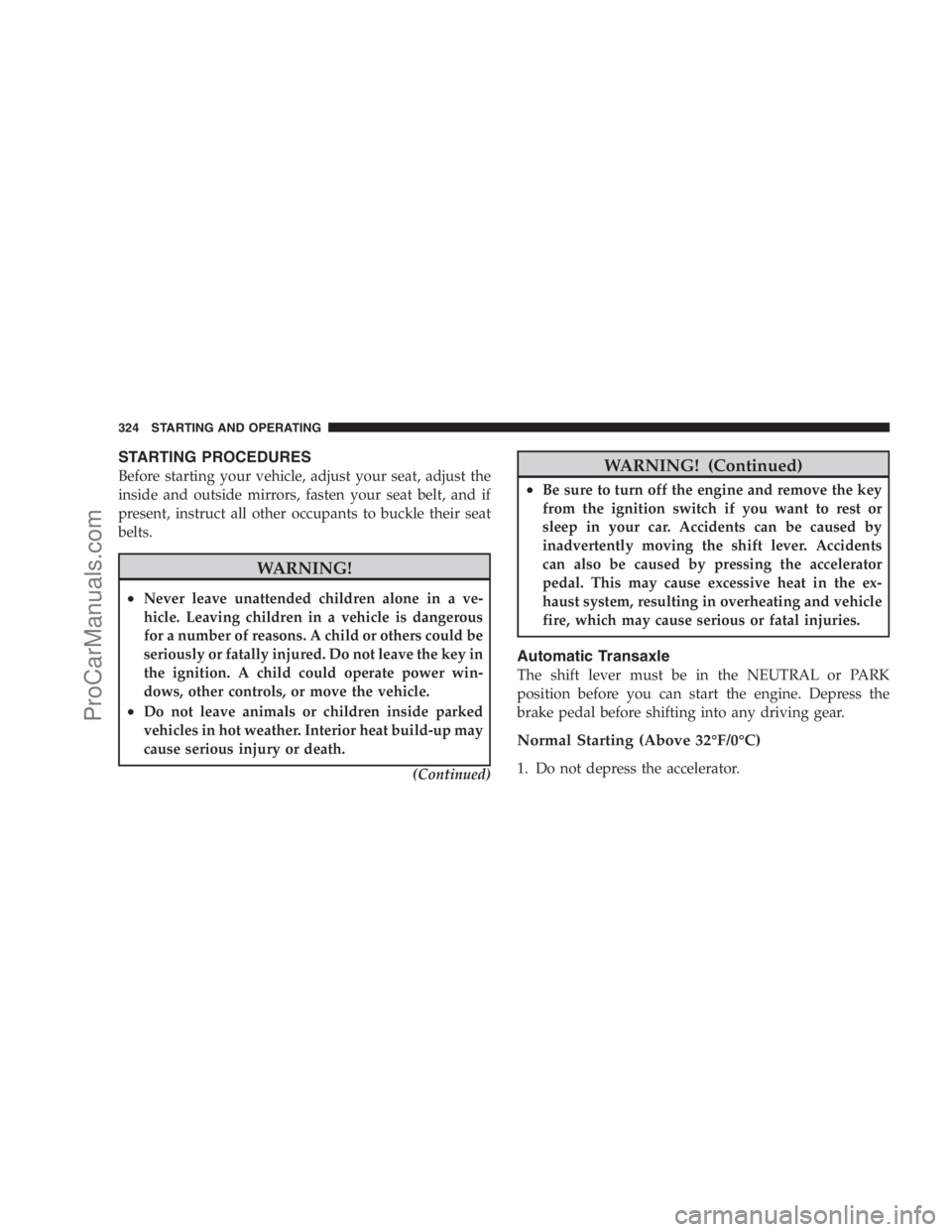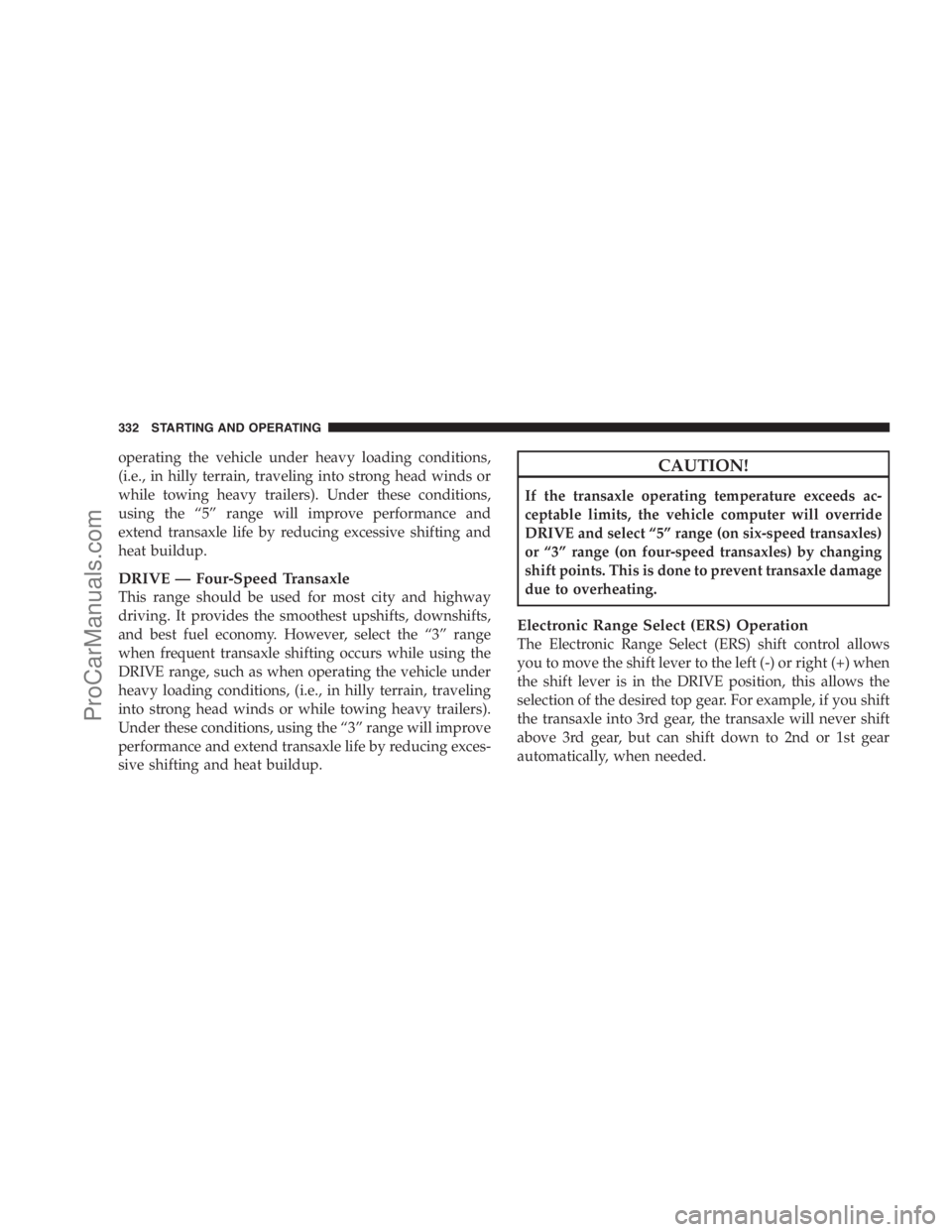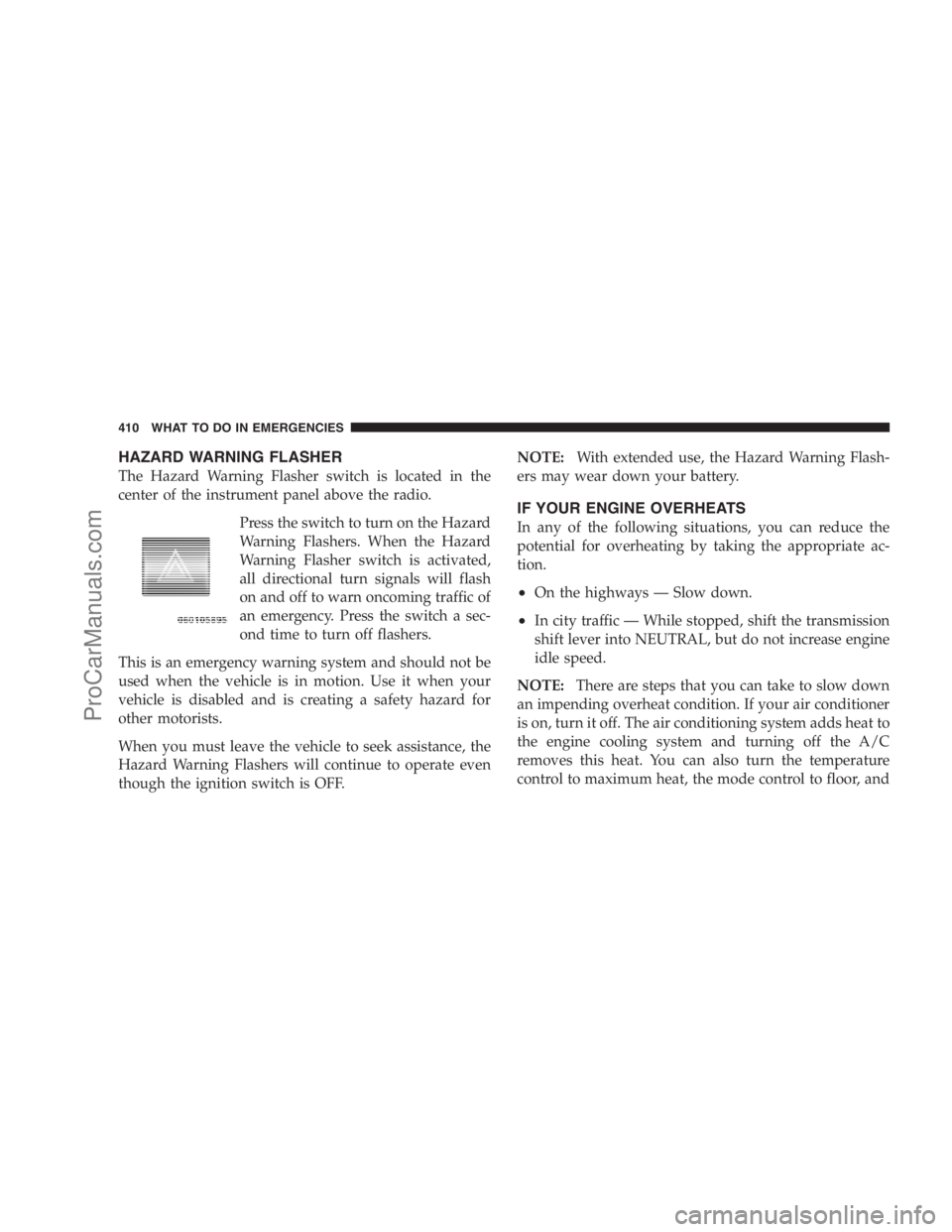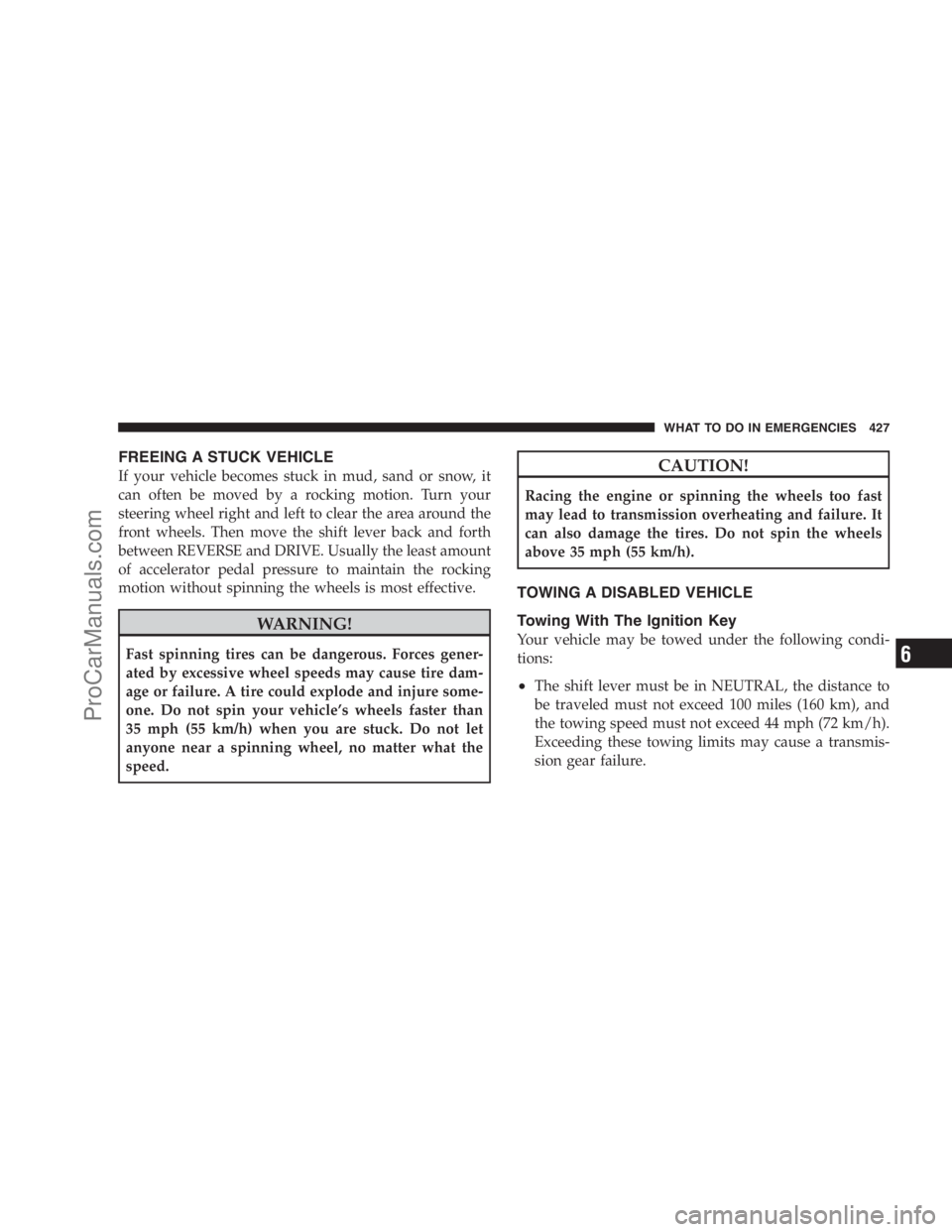Page 326 of 534

STARTING PROCEDURES
Before starting your vehicle, adjust your seat, adjust the
inside and outside mirrors, fasten your seat belt, and if
present, instruct all other occupants to buckle their seat
belts.
WARNING!
•Never leave unattended children alone in a ve-
hicle. Leaving children in a vehicle is dangerous
for a number of reasons. A child or others could be
seriously or fatally injured. Do not leave the key in
the ignition. A child could operate power win-
dows, other controls, or move the vehicle.
•Do not leave animals or children inside parked
vehicles in hot weather. Interior heat build-up may
cause serious injury or death.
(Continued)
WARNING! (Continued)
•Be sure to turn off the engine and remove the key
from the ignition switch if you want to rest or
sleep in your car. Accidents can be caused by
inadvertently moving the shift lever. Accidents
can also be caused by pressing the accelerator
pedal. This may cause excessive heat in the ex-
haust system, resulting in overheating and vehicle
fire, which may cause serious or fatal injuries.
Automatic Transaxle
The shift lever must be in the NEUTRAL or PARK
position before you can start the engine. Depress the
brake pedal before shifting into any driving gear.
Normal Starting (Above 32°F/0°C)
1. Do not depress the accelerator.
324 STARTING AND OPERATING
ProCarManuals.com
Page 334 of 534

operating the vehicle under heavy loading conditions,
(i.e., in hilly terrain, traveling into strong head winds or
while towing heavy trailers). Under these conditions,
using the “5” range will improve performance and
extend transaxle life by reducing excessive shifting and
heat buildup.
DRIVE — Four-Speed Transaxle
This range should be used for most city and highway
driving. It provides the smoothest upshifts, downshifts,
and best fuel economy. However, select the “3” range
when frequent transaxle shifting occurs while using the
DRIVE range, such as when operating the vehicle under
heavy loading conditions, (i.e., in hilly terrain, traveling
into strong head winds or while towing heavy trailers).
Under these conditions, using the “3” range will improve
performance and extend transaxle life by reducing exces-
sive shifting and heat buildup.
CAUTION!
If the transaxle operating temperature exceeds ac-
ceptable limits, the vehicle computer will override
DRIVE and select “5” range (on six-speed transaxles)
or “3” range (on four-speed transaxles) by changing
shift points. This is done to prevent transaxle damage
due to overheating.
Electronic Range Select (ERS) Operation
The Electronic Range Select (ERS) shift control allows
you to move the shift lever to the left (-) or right (+) when
the shift lever is in the DRIVE position, this allows the
selection of the desired top gear. For example, if you shift
the transaxle into 3rd gear, the transaxle will never shift
above 3rd gear, but can shift down to 2nd or 1st gear
automatically, when needed.
332 STARTING AND OPERATING
ProCarManuals.com
Page 342 of 534
Be sure the parking brake is firmly set when parked and
the gear selector lever is in the PARK position. When
parking on a hill you should apply the parking brake
before placing the gear selector lever in PARK, otherwise
the load on the transaxle locking mechanism may make it
difficult to move the gear selector lever out of PARK.
WARNING!
•Always fully apply the parking brake when leav-
ing your vehicle, or it may roll and cause damage
or injury. Also be certain to leave an automatic
transaxle in PARK. Failure to do so may allow the
vehicle to roll and cause damage or injury.
•Be sure the parking brake is fully disengaged
before driving. Failure to do so can lead to brake
problems due to excessive heating of the rear
brakes.
Parking Brake
340 STARTING AND OPERATING
ProCarManuals.com
Page 408 of 534

The automatic transaxle fluid and filter should be
changed if you REGULARLY tow a trailer for more than
45 minutes of continuous operation. Refer to the “Main-
tenance Schedule” in Section 8 of this manual for trans-
axle fluid change intervals.
NOTE:
•Check the automatic transaxle fluid level before tow-
ing.
•The six-speed automatic transaxle is sealed and re-
quires an authorized dealer to check the transaxle
fluid.
Towing Tips — Electronic Speed Control (If
Equipped)
•
Do not use in hilly terrain or with heavy loads.
•When using the speed control, if you experience speed
drops greater than 10 mph (16 km/h), disengage until
you can get back to cruising speed.
•Use speed control in flat terrain and with light loads to
maximize fuel efficiency.
Towing Tips — Cooling System
To reduce potential for engine and transaxle overheating,
take the following actions:
•City Driving
When stopped for short periods of time, put transaxle
gear selector lever in NEUTRAL but do not increase
engine idle speed.
•Highway Driving
Reduce speed.
•Air Conditioning
Turn off temporarily.
406 STARTING AND OPERATING
ProCarManuals.com
Page 412 of 534

HAZARD WARNING FLASHER
The Hazard Warning Flasher switch is located in the
center of the instrument panel above the radio.
Press the switch to turn on the Hazard
Warning Flashers. When the Hazard
Warning Flasher switch is activated,
all directional turn signals will flash
on and off to warn oncoming traffic of
an emergency. Press the switch a sec-
ond time to turn off flashers.
This is an emergency warning system and should not be
used when the vehicle is in motion. Use it when your
vehicle is disabled and is creating a safety hazard for
other motorists.
When you must leave the vehicle to seek assistance, the
Hazard Warning Flashers will continue to operate even
though the ignition switch is OFF.NOTE:With extended use, the Hazard Warning Flash-
ers may wear down your battery.
IF YOUR ENGINE OVERHEATS
In any of the following situations, you can reduce the
potential for overheating by taking the appropriate ac-
tion.
•On the highways — Slow down.
•In city traffic — While stopped, shift the transmission
shift lever into NEUTRAL, but do not increase engine
idle speed.
NOTE:There are steps that you can take to slow down
an impending overheat condition. If your air conditioner
is on, turn it off. The air conditioning system adds heat to
the engine cooling system and turning off the A/C
removes this heat. You can also turn the temperature
control to maximum heat, the mode control to floor, and
410 WHAT TO DO IN EMERGENCIES
ProCarManuals.com
Page 429 of 534

FREEING A STUCK VEHICLE
If your vehicle becomes stuck in mud, sand or snow, it
can often be moved by a rocking motion. Turn your
steering wheel right and left to clear the area around the
front wheels. Then move the shift lever back and forth
between REVERSE and DRIVE. Usually the least amount
of accelerator pedal pressure to maintain the rocking
motion without spinning the wheels is most effective.
WARNING!
Fast spinning tires can be dangerous. Forces gener-
ated by excessive wheel speeds may cause tire dam-
age or failure. A tire could explode and injure some-
one. Do not spin your vehicle’s wheels faster than
35 mph (55 km/h) when you are stuck. Do not let
anyone near a spinning wheel, no matter what the
speed.
CAUTION!
Racing the engine or spinning the wheels too fast
may lead to transmission overheating and failure. It
can also damage the tires. Do not spin the wheels
above 35 mph (55 km/h).
TOWING A DISABLED VEHICLE
Towing With The Ignition Key
Your vehicle may be towed under the following condi-
tions:
•The shift lever must be in NEUTRAL, the distance to
be traveled must not exceed 100 miles (160 km), and
the towing speed must not exceed 44 mph (72 km/h).
Exceeding these towing limits may cause a transmis-
sion gear failure.
WHAT TO DO IN EMERGENCIES 427
6
ProCarManuals.com
Page 446 of 534

WARNING!
A hot exhaust system can start a fire if you park over
materials that can burn. Such materials might be
grass or leaves coming into contact with your exhaust
system. Do not park or operate your vehicle in areas
where your exhaust system can contact anything that
can burn.
In unusual situations involving grossly malfunctioning
engine operation, a scorching odor may indicate severe
and abnormal catalyst overheating. If this occurs, the
vehicle should be stopped, the engine shut OFF and the
vehicle allowed to cool. Thereafter, service, including a
tune-up to manufacturer’s specifications, should be ob-
tained immediately.To minimize the possibility of catalyst damage:•Do not shut OFF the engine or interrupt the ignition
when the transaxle is in gear and the vehicle is in
motion.
•Do not try to start the engine by pushing or towing the
vehicle.
•Do not idle the engine with any spark plug wires
disconnected or removed, such as when diagnostic
testing, or for prolonged periods during very rough
idling or malfunctioning operating conditions.
Maintenance-Free Battery
The top of the maintenance-free battery is permanently
sealed. You will never have to add water, nor is periodic
maintenance required.
444 MAINTAINING YOUR VEHICLE
ProCarManuals.com
Page 518 of 534

Disposal
Antifreeze (Engine Coolant)............... 454
Engine Oil........................... 441
Domelight............................. 173
Door Locks............................. 31
Door Locks, Automatic.................... 34
Door Opener, Garage..................... 197
Drive Shaft Universal Joints................ 448
Driving
On Slippery Surfaces.................... 334
Through Flowing, Rising, or Shallow
Standing Water......................... 335
DVD Player (Video Entertainment System™).... 297
E-85 Fuel............................. 383
Electric Remote Mirrors................... 104
Electrical Power Outlets................... 206
Electronic Brake Control System............. 344
Brake Assist System.................... 346Electronic Stability Program............... 347
Electronic Speed Control (Cruise Control)...... 183
Electronic Stability Program (ESP)............ 347
Electronic Vehicle Information Center
(EVIC).............................192,252
Emergency, In Case of
Hazard Warning Flasher................. 410
Jacking...........................412,415
Jump Starting......................... 424
Overheating.......................... 410
Emission Control System Maintenance......436,484
Engine............................433,434
Air Cleaner.......................... 441
Block Heater......................... 327
Break-In Recommendations................ 93
Checking Oil Level..................... 438
Compartment......................433,434
Coolant (Antifreeze).................... 480
Cooling............................. 450
516 INDEX
ProCarManuals.com